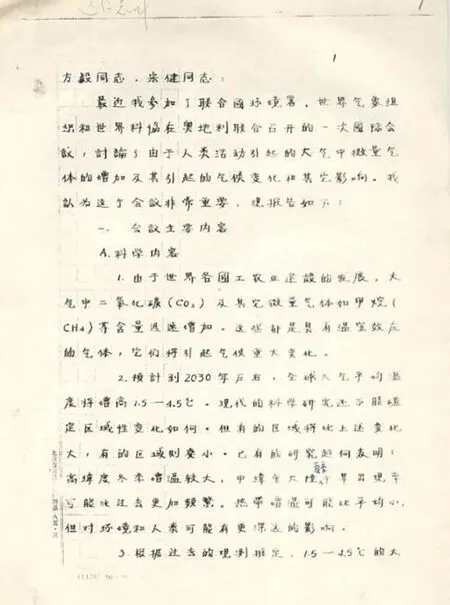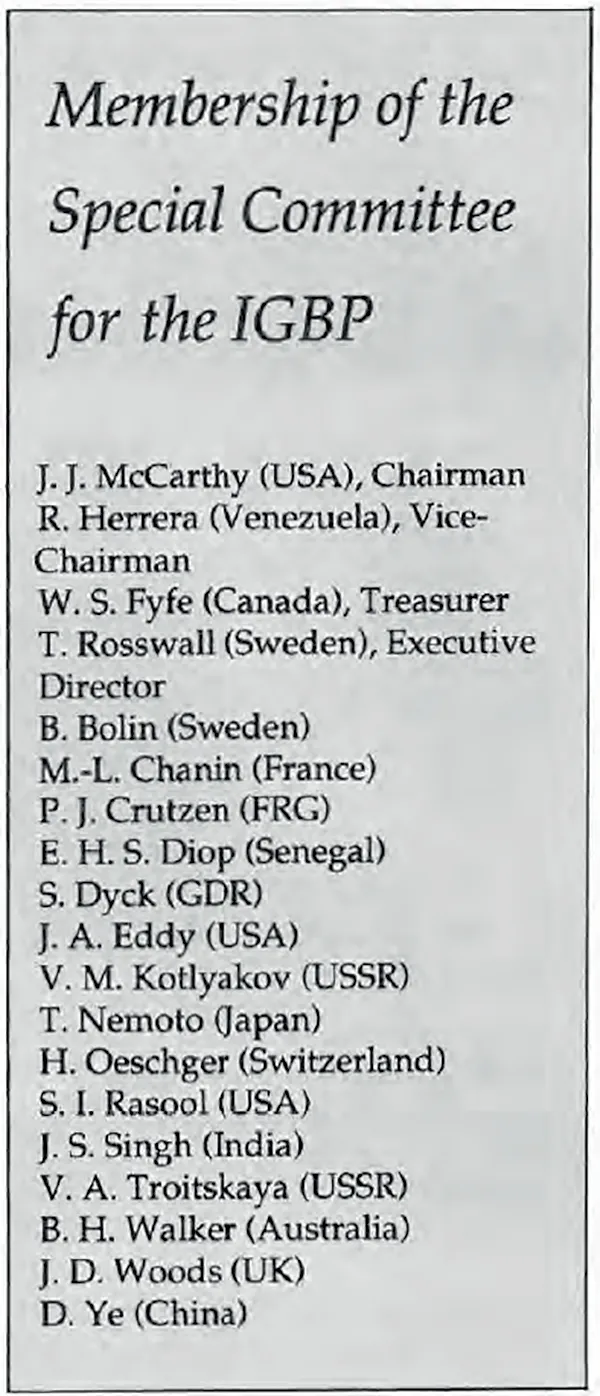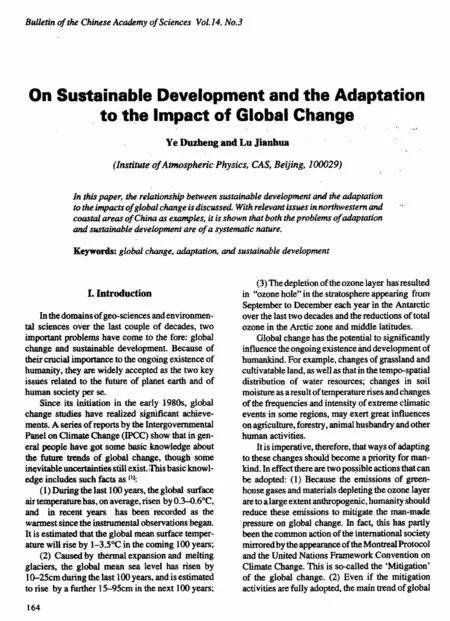On the role of global change science in sustainable development:Reflecting on Ye Duzheng’s contributions
Jianhua Lu
Sun Yat-sen University,China
Abstract Ye Duzheng was a world-renowned climate scientist and a pioneer of global change science in China and across the world.This paper revisits his ideas on linking global change science to sustainable development and his understanding of orderly human activities,along with his activities in leading research on global change science beginning in the early 1980s.Ye’s work has clearly shown that literacy in global change science and Earth system science and the interaction between the social and natural sciences and between policymakers and stakeholders at different levels are essential to sustainable development.
Keywords Global change,orderly human activities,sustainable development,Ye Duzheng
1.Introduction
Beginning in the 1950s,Professor Ye Duzheng (21 February 1916–16 October 2013) played a key role in the development of modern meteorology in China and was a world-renowned Earth scientist who made many important contributions to atmospheric and climate sciences (Fu,2017;Hoskins,2014;Lau,2017;Lu and Schneider,2017).Because of his many far-reaching achievements,he was awarded the 2005 China National Preeminent Science and Technology Award–the highest prize for a scientist,for contributions to the development of science and technology by China’s central government–and the prestigious International Meteorological Organization (IMO) Prize by the World Meteorological Organization (WMO) in 2003.Professor Ye was the founder of global change science in China and was among the pioneers who initiated and steered research on international global change in the early 1980s (Taba,2003).Among Professor Ye’s fundamental contributions to both basic and applied science in meteorology,the WMO,when bestowing the IMO prize on him,singled out ‘the initiation of studies on global change and its relationships with sustainable development,orderly human activities and adaptation to its impacts’.
SinceOur Common Future(the Brundtland Report) defined ‘sustainable development’ as ‘development that meets the needs of the present generation without compromising the ability of future generations to meet their own needs’ (WCED,1987),the idea of sustainable development has been widely accepted by the international community.It was reflected in Agenda 21–a product of the 1992 United Nations Conference on Environment and Development (also known as the ‘Earth Summit’)held in Rio de Janeiro,Brazil–and was accepted by many countries,including China.Agenda 21 addresses issues regarding social and economic development by focusing on the conservation and preservation of the environment and natural resources.The vitality of the concept of sustainable development was further underlined in the 2030 Agenda for Sustainable Development (Agenda 30),which was implemented by the United Nations in 2015 and announced 17 sustainable development goals.Indeed,the initial conceptualisation of sustainable development in the 1980s was largely related to common concerns relating to environmental deterioration and the depletion of the world’s resources owing to rapid industrialisation and overconsumption across the globe.Accordingly,a greater emphasis was laid on policies on social and economic development than on basic science related to the Earth’s systems.
On the contrary,the emergence of global change science in the early 1980s was largely associated with increasing concerns about global climate change in the scientific community,among which fears of its effects had been realized even during the 1950s and 1960s (see e.g.Rossby,1959;Tu,1961).Although the adverse climatic effects of greenhouse gases,including carbon dioxide,had long been known,the link between the observed trend of warming since the 1850s and the increase in carbon dioxide content in the atmosphere,induced by the widespread use of fossil fuels,was not clear even though some had suspected such a connection (see e.g.Bolin and Eriksson,1959;Callendar,1938;Keeling,1960;Rossby,1959).That situation persisted until 1979,when the Charney Report provided a rough but science-based estimate that the doubling of carbon dioxide content in the atmosphere may lead to a global average warming of 1.5–4.5°C(Charney et al.,1979).The 1970s ushered in the realisation that it is necessary to consider the climate as a system of atmosphere–ocean–cryosphere–land(i.e.a climate system) to understand the causes of climate change and predict future changes in climate(WMO and ICSU,1975).
Based on proposals made at the United Nations Conference on the Human Environment in Stockholm,the World Climate Research Programme(WCRP) was launched in 1979,the same year in which the Charney Report was published.Not long after the WCRP was launched,the international scientific community realized the pivotal role of the interactions between global biogeochemical processes and physical processes in global environmental changes.After years of discussion,the International Council of Scientific Unions (ICSU)launched the International Geosphere–Biosphere Programme (IGBP),marking the establishment of global change science or Earth system science(IGBP,1986).Global change,as defined by the IGBP,encompasses any change in the Earth’s environment (changes in the Earth,oceans,atmosphere,biosphere and cryosphere) due to any cause (IGBP,1986).Professor Ye played a prominent role in both international programmes and proposed insightful ideas to the international community.This paper presents his ideas on the role of global change science in sustainable development and his activities in pursuing those ideas in research projects.
2.Ye’s early activities during the establishment of global change science
In 1978,Ye Duzheng was appointed as the directorgeneral of the Institute of Atmospheric Physics at the Chinese Academy of Sciences (CAS),and in 1979 was appointed to a three-member working group(representing China) under the Agreement on Science and Technology Cooperation between China and the United Sates (US),which was signed during Deng Xiaoping’s historic visit to the US in January 1979.He also led a delegation of Chinese meteorological scientists to the US in September 1979.In 1981,Ye was nominated as the vice-president of CAS in charge of geoscience research at the academy.Based on his reputation in the international meteorological community as well as his vast experience in international cooperation in science and technology,Ye was selected and served as a member of the Joint Scientific Committee of the WCRP from 1982 to 1988.He led China’s delegation to attend the 1985 Villach Conference on climate change held in Austria (Figure 1).After the conference,he wrote a letter (Figure 2) to Fang Yi (then a vice-premier of China’s State Council) and Song Jian (then the director of the National Science and Technology Commission).That correspondence led to the establishment of China’s National Committee on Climate Research,of which Ye served as chair from 1985 to 1999 (Fu,2017).

Figure 1.Ye Duzheng (third from right in the second row) at the 1985 Villach Conference on climate change held in Austria.

Figure 2.Ye Duzheng’s letter to Fang Yi and Song Jian,written after Ye attended the 1985 Villach Conference.

Figure 3. Members of the special committee for the IGBP.Source:IGBP (1989).
In 1984,the distinguished American atmospheric scientist Thomas Malone,a close friend of Ye,and Juan Roederer from the ICSU visited China and met with Ye under the arrangement of the China Association for Science and Technology.While introducing Chinese scientists to the concept of global change,both Ye and Malone agreed that research activities related to global change should be organized and that younger scientists in China should be involved where this work included the planning of new international research programmes.The ICSU organized the first symposium on global change in Ottawa,Canada.Ye and his colleague,Fu Congbin,were invited to present their position paper,titled ‘Climatic change:A global and multidisciplinary theme’ (Yeh and Fu,1985).In it,they discussed the differences and connections between climatic and global changes and pointed out that the decadal and centennial scales should be used as focal timescales for the relevant research.During the symposium,the participants agreed that a new programme in addition to the WCRP (i.e.the IGBP) was needed to integrate the biogeochemical and physical processes of the climate.
The IGBP was formally launched in 1988 by the ICSU after 4 years of preparation.As a pioneer of the programme,Ye was nominated as a member of the special committee for the IGBP (Figure 3).While some in China opposed this endeavour and argued that the country should focus on internal scientific issues,Ye successfully led a group of Chinese scientists to become actively involved in research on global change.The China National Committee of the IGBP was subsequently established,and Ye served as its chairman for its first and second terms,beginning in 1988.By conducting multifaceted research,Ye and his Chinese colleagues made significant contributions to global change science,not only in China,but also at the international level (Fu,2017;Ye and Chen,1992).The Global Change Research Centre for Temperate East Asia was established in China in 1994 as the first of its kind and was part of the global change System for Analysis,Research and Training (START) family.Ye was the first director of the centre (Fu,2017).Research on global change in China has subsequently grown into a long-term,national-level research programme in the first two decades of the 21st century (Zhou et al.,2015).
3.Linking global change science to sustainable development
Before the publication of the third assessment report by the Intergovernmental Panel on Climate Change in 2001,Ye thought it necessary to link global change science,particularly adaptation to the impact of global change,to sustainable development.‘Adaptation’ here refers to the adjustment in natural or human systems to respond to expected changes in climate and their effects in order to lessen harm or exploit beneficial opportunities (Taba,2003).In the early 1990s,the Chinese Government announced that sustainable development was going to be the key national strategy for the country’s social and economic development,and China’s Agenda 21 was announced soon after the United Nation’s Earth Summit held in Rio de Janeiro.However,few people took adaptation to global change seriously at the level of national policy,let alone the detailed measures announced in Agenda 21.This was likely to have been due to the considerable uncertainty in the projection of future climate change,and particularly the even greater uncertainty in predictions of its regional patterns.
Ye thought that the lack of awareness of global change among large segments of policymakers and the general public could pose a significant hindrance to the success of sustainable development in China.Therefore,Ye,together with Professor Zhang Xinshi,a leading botanist and ecologist who had been actively involved in the IGBP,proposed the Xiangshan Science Conference–similar to the Gordon Science Conference in the US.The aim was to discuss ways to link sustainable development to adaptation to global change,and they invited 30 leading scientists in China from the fields of climatology,water resources,water and soil conservation,hydrology,plant ecology,glaciology and estuarine science.I had then just finished my PhD under Professor Ye’s supervision,and I was asked to help organize the 3-day conference.Despite the multidisciplinary nature of the conference,Ye ensured that the discussion focused on the relationship between sustainable development and global change and developed a long summary of the dialogue at the end of the conference.The summary was distilled into a paper (Ye and Lu,2000;Figure 4).

Figure 4. The first page of the paper by Ye and Lu (2000) on sustainable development and global change.
In the paper,Ye expressed his thoughts on the close linkage between global change science and sustainable development.He claimed that adaptation to global changes must follow the principles of sustainable development;that is,society as a whole must alter its unsustainable lifestyle and style of economic development.Otherwise,adaptation for the sake of only temporary or local interests may damage the environment and lead to even more destructive global change.Similarly,sustainable development will not achieve its goals without taking into account future global changes in climate.
Ye and Lu (2000) also analysed the systematic nature of sustainable development and adaptation to global change,first based on general principles and then by considering the impacts of such changes on the shortage of water resources in north-western China and the rise in levels in the Yangtze River delta as two examples.
Just as the emergence of global change science is based on the understanding that the Earth as a whole is a system composed of different,mutually interactive components,adaptation to the impacts of global change must also be systematic,transcending the boundaries between regions,organisations and business sectors.Otherwise,the situation may well worsen,and adaptation cannot be successful if each region,organisation and business sector considers only its own interests (Ye and Lu,2000).Similarly,sustainable development should be systematic.While sustainable development goals could be set up for different regions as well as different social and economic sectors,the success of sustainable development depends on coordination among those different regions and sectors.Indeed,the inexorable trend towards regional and global economic integration succinctly demonstrates the systematic nature of sustainable development.Ye and Lu (2000) claimed that ‘if they[different regions and social/economic sectors]think of themselves as part of the whole,co-operating with each other–even making sacrifices where necessary–will benefit the whole overall’.Indeed,‘only the sustainable development of the system as a whole can really be sustainable’.
4.On the concept of ‘orderly human activities’
As stated in Ye and Lu (2000),global change,including the trend of global warming and environmental deterioration,has been largely caused by human activities,such as the excessive use of fossil fuels,overcultivation,overgrazing and large-scale deforestation.On the multidecadal to centennial timescales,anthropogenic changes in the climate and the environment around the globe are nearly the same as,or even larger than,naturally driven changes(Taba,2003;Ye and Lu,2000).That understanding prompted the idea of ‘orderly human activities’,which were defined by Ye and his colleagues as human activities that can ensure that the life-supporting environment as a whole is maintained without notable degeneration,or even with some improvement,while meeting the demands of socioeconomic development (Ye et al.,2001).It is clear that this definition is based on the principle of sustainable development.That is to say,sustainable development is not only the goal of orderly human activities but is also the criterion used to determine whether large-scale human activities are orderly (Fu,2017;Ye and Dong,2010).
Ye et al.(2001) discussed in detail the characteristics of orderly human activities,including their goal towards sustainable development,their hierarchical nature,systematic nature and scale effect.
Participants in orderly human activities include not only governments and policymakers at different levels,Ye et al.(2001) claimed,but also the scientific community,the public and other stakeholders.In particular,Ye et al.(2001) emphasized the importance of scientific research in promoting environmental awareness in the policymaking process of governments,and in encouraging mutual feedback and interaction between policymakers and stakeholders.Indeed,literacy in global change science may well contribute significantly to integrating and coordinating the activities of different participants to achieve the goals of sustainable development.
Ye et al.(2001) further put forward an approach to research on orderly human activities that should be closely integrated with the policymaking process and activities of stakeholders at different levels.They stressed that interdisciplinary cooperation between the social sciences and natural sciences is pivotal to the success of such research and that demonstration areas of orderly human activities that coordinate policymakers,scientists and stakeholders should be established.
5.Summary
Ye Duzheng was a world-renowned climate scientist,the founder of global change science in China and a pioneer of global change research.This paper has revisited his leading ideas on linking global change science to sustainable development and his views of orderly human activities,together with his work in leading global change research in China,beginning in the early 1980s.It is clear from Ye’s work that literacy in global change science and Earth system science and the interaction between the social and natural sciences and between policymakers and stakeholders at different levels of governance are essential to achieve sustainable development.Global change science has moved to a new phase of ‘future Earth’ research (Zhou et al.,2015).Understanding the Earth’s systems,including human activities,as a whole and exploring the relation between global change and sustainable development are expected to contribute to a better future for the planet and the welfare of its inhabitants.
Declaration of conflicting interests
The author declared no potential conflicts of interest with respect to the research,authorship and/or publication of this article.
Funding
The author disclosed receipt of the following financial support for the research,authorship and/or publication of this article:This study was supported by the National Natural Science Foundation of China (grant number 42042011).

